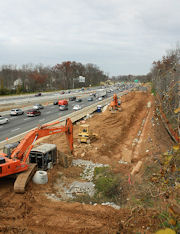The McDonnell administration hopes that VDOT’s “design-build” approach to highway engineering will advance projects more quickly and save millions of dollars. But public accountability may suffer.
By James A. Bacon
Transportation Secretary Sean Connaughton liked this story so much that he told it twice this week during the September meeting of the Commonwealth Transportation Board in Portsmouth. When Virginia Department of Transportation (VDOT) engineers conducted the initial design for the I-495 Beltway, he said, they estimated that the project would cost $3 billion. But when Transurban, the Australia-based toll road builder/operator, took a crack at the same design challenge, the cost dropped to $1.5 million. What’s more, said Connaughton, “They added four lanes; we would have added only two.”
One big difference between the two designs was that VDOT envisioned the necessity of acquiring more than 600 houses and commercial buildings while Transurban figured out how to build the project with a much smaller footprint, saving hundreds of millions of dollars in right-of-way acquisition costs.
And that is why Connaughton is a big believer in “design-build” contracts. He wasn’t knocking the professionalism of the VDOT engineers. But he did make the argument that soliciting a design from a private-sector group like Transurban could yield fresh, creative thinking on how to design a project more economically.
Under the McDonnell administration there will be more design-build contracts in Virginia’s transportation future, a philosophical shift that represents a big change in how VDOT manages road projects and how it interacts with the public. Design-build offers the potential to cut the cost of big-figure mega-projects. But because the projects move so much faster, the approach also threatens to reduce meaningful public involvement. Indeed, the controversial Charlottesville Bypass, which is being rushed to bids, may be a case in point.
Traditionally, VDOT used the “design-bid-build” approach to designing and building roads. It was a linear process, Charlie Kilpatrick, chief deputy commissioner, explained to the CTB. Projects moved sequentially from one phase to the next, a process that could take years. The contracts were very “prescriptive,” with the quantity of materials specified precisely. Contractors liked it because it was low-risk. If there were overruns in the quantity of materials, VDOT would pay for them. The process had all been worked out, and everyone was comfortable with it.
The design-build approach transfers much of the risk to the contractors but gives them more flexibility in solving problems. Contractors, who typically partner with engineering firms, are required to meet broad specifications and guidelines but have considerable latitude in figuring out how to meet them. If they miscalculate the volume of materials required, they are liable for the overrun. An advantage of the process is the ability to run many of the design and construction phases concurrently. Construction could be underway on one section of the project even while engineers were designing another section. In theory, completing projects more quickly cuts construction costs.
Another reason VDOT is resorting to design-build projects right now is that the department has largely run out of off-the-shelf project designs. In the past, VDOT engineers would do rough designs entailing about 30% of the work in order to develop cost estimates and move quickly to take advantage of unexpected funding opportunities. When the 2007 recession hit, VDOT curtailed its engineering work in an effort to cut costs. Later, when the Obama administration started distributing highway construction dollars under the American Recovery and Reinvestment Act (the so-called “stimulus” bill), VDOT drew down its off-the-shelf plans. Now, said Virginia Highway Commissioner Gregory A. Whirley, the cupboard is almost bare. VDOT’s updated strategic plan calls for setting aside 10% to 15% of the state’s construction program budget for preliminary engineering in order to beef up its project inventory. Until then, the department will use more design-build, in effect outsourcing the design to engineering-construction firms and partnerships.
James A. Davis, former president of Shenandoah University in Winchester, said Virginia’s higher education sector went through a similar transition two decades ago. Colleges and contractors were comfortable with the design-bid-build process and were reluctant to change. “You have to be very clear about the specifications,” he told the board. “It’s a very different management process. It’s more creative, and you don’t know until you reach 90% [project completion] what the final cost will be.”
Despite the anxieties, design-build did cut the construction time of college buildings dramatically and saved considerable money. It’s largely standard for the higher ed sector today.
On the other hand, as Davis conceded, highway projects are typically more complex than college buildings. Also, he might have added, highways have a far greater impact on the public than college buildings do.
“How do we reconcile this with our obligation to consult with taxpayers?” asked James E. Rich, the Culpeper District representative on the CTB, who opposed the Charlottesville Bypass. It wasn’t an academic question. Read more.



